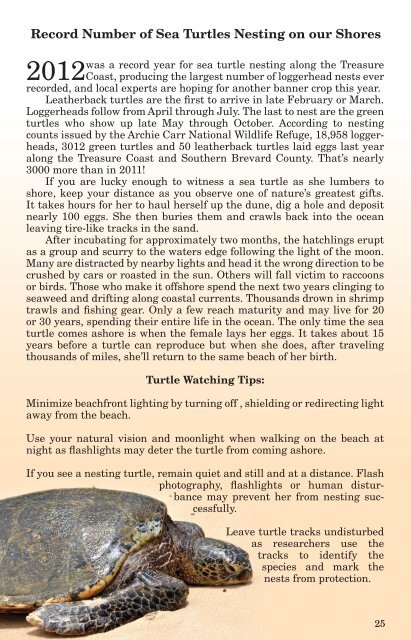InsideTrack Almanac 18_2 ISSUU
Create successful ePaper yourself
Turn your PDF publications into a flip-book with our unique Google optimized e-Paper software.
Record Number of Sea Turtles Nesting on our Shores<br />
was a record year for sea turtle nesting along the Treasure<br />
2012 Coast, producing the largest number of loggerhead nests ever<br />
recorded, and local experts are hoping for another banner crop this year.<br />
Leatherback turtles are the first to arrive in late February or March.<br />
Loggerheads follow from April through July. The last to nest are the green<br />
turtles who show up late May through October. According to nesting<br />
counts issued by the Archie Carr National Wildlife Refuge, <strong>18</strong>,958 loggerheads,<br />
3012 green turtles and 50 leatherback turtles laid eggs last year<br />
along the Treasure Coast and Southern Brevard County. That’s nearly<br />
3000 more than in 2011!<br />
If you are lucky enough to witness a sea turtle as she lumbers to<br />
shore, keep your distance as you observe one of nature’s greatest gifts.<br />
It takes hours for her to haul herself up the dune, dig a hole and deposit<br />
nearly 100 eggs. She then buries them and crawls back into the ocean<br />
leaving tire-like tracks in the sand.<br />
After incubating for approximately two months, the hatchlings erupt<br />
as a group and scurry to the waters edge following the light of the moon.<br />
Many are distracted by nearby lights and head it the wrong direction to be<br />
crushed by cars or roasted in the sun. Others will fall victim to raccoons<br />
or birds. Those who make it offshore spend the next two years clinging to<br />
seaweed and drifting along coastal currents. Thousands drown in shrimp<br />
trawls and fishing gear. Only a few reach maturity and may live for 20<br />
or 30 years, spending their entire life in the ocean. The only time the sea<br />
turtle comes ashore is when the female lays her eggs. It takes about 15<br />
years before a turtle can reproduce but when she does, after traveling<br />
thousands of miles, she’ll return to the same beach of her birth.<br />
Turtle Watching Tips:<br />
Minimize beachfront lighting by turning off , shielding or redirecting light<br />
away from the beach.<br />
Use your natural vision and moonlight when walking on the beach at<br />
night as flashlights may deter the turtle from coming ashore.<br />
If you see a nesting turtle, remain quiet and still and at a distance. Flash<br />
photography, flashlights or human disturbance<br />
may prevent her from nesting successfully.<br />
Leave turtle tracks undisturbed<br />
as researchers use the<br />
tracks to identify the<br />
species and mark the<br />
nests from protection.<br />
Volume <strong>18</strong> • Issue 2 25


